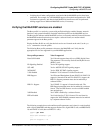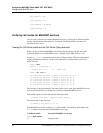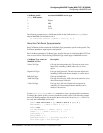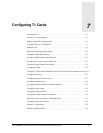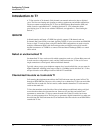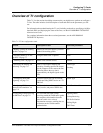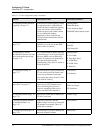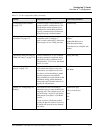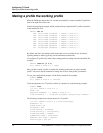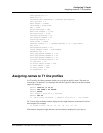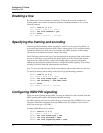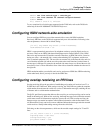
Configuring T1 Cards
Overview of T1 configuration
APX 8000/MAX TNT/DSLTNT Physical Interface Configuration Guide Preliminary May 9, 2000 7-3
Overview of T1 configuration
Table 7-1 lists the sections describing common tasks you might have to perform to configure a
T1 line. The table includes a brief description of each task and lists the parameters you will
use.
For information about administering the T1 card, including such tasks as specifying a facilities
data link (FDL) and displaying the status of the lines, see the APX 8000/MAX TNT/DSLTNT
Administration Guide.
For complete information about the associated parameters, see the APX 8000/MAX
TNT/DSLTNT Reference.
Table 7-1. T1 line configuration tasks
Section Description of task Associated parameters
“Making a profile the working
profile” on page 7-6
Before you can edit a profile, you must
make it the working profile.
N/A
“Assigning names to T1 line
profiles” on page 7-7
Assign a name to the T1 profile. Name
“Enabling a line” on page 7-8 Make a line available for use. Enabled
“Specifying the framing and
encoding” on page 7-8
Each T1 line requires framing and
encoding. Framing specifies the format
for the sequence of bits sent on the line.
Encoding affects the way data is
represented by the digital signals on the
line.
Frame-Type
Encoding
“Configuring ISDN PRI
signaling” on page 7-8
You must specify the type of network
switch providing ISDN service on a T1
PRI line.
Switch-Type
“Configuring ISDN
network-side emulation” on
page 7-9
ISDN emulation enables you to build,
send, receive, and process ISDN data.
ISDN-Emulation-Side
“Configuring overlap receiving
on PRI lines” on page 7-9
T1 or E1 PRI lines with overlap
receiving enable the TAOS unit to gather
the complete called number from the
network switch via a series of
Information messages, enabling the use
of features such as called-number
authentication.
Signaling-Mode
Overlap-Receiving
PRI-Prefix-Number
Trailing-Digits
T302-Timer



